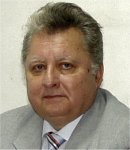|
Plenary
Lecture
Semantic Schema: A Graph Based Mechanism for Cooperating
Structures in Knowledge Representation

Professor Nicolae Tandareanu
Faculty of Mathematics and Computer Science
University of Craiova
Romania
E-mail:
ntand@rdslink.ro
Abstract:
A semantic schema S is a graph structure such that
each arc is labeled by an element of a Peano algebra.
Two kinds of computations can be defined in such a
structure: a formal computation and a semantic
computation. The result of a formal computation is an
element of a certain Peano algebra generated by means of
the arcs of S. This is an abstract computation. The
semantic computation is defined by means of an
interpretation such that each node of S becomes an
object of a real world and an arc describes a
transformational process of two objects. Finally the
result of the formal computation is interpreted by means
of the semantic computation.
In this lecture we are concerned with recent progress in
this domain. More precisely, the use of semantic schemas
to obtain cooperating structures in order to increase
the generative power of this mechanism of knowledge
representation and reasoning systems is presented. We
focus on the following cooperating structures based on
semantic schemas: master-slave systems and hierarchical
distributed reasoning systems. The first structure
includes one master schema and several slave-schemas.
These structures cooperate in a specific manner in order
to find an answer to a query. The second structure is an
arborescent one, such that each node is a semantic
schema and the cooperation is based on a transfer of
knowledge between nodes. Other kinds of cooperating
structures are also discussed: cooperation based on
maximal graphs and cooperation based on inheritance.
Several applications of cooperating structures based on
semantic schemas are discussed: image generation,
semantics of communication, contact centers, dialogue
systems.
Brief Biography of the Speaker:
Nicolae Tandareanu received the diploma in mathematics
and Ph.D. from the University of Bucharest, Romania, in
1970 and 1975, respectively. He is currently Professor
of Computer Science at the Faculty of Mathematics and
Computer Science at University of Craiova, Romania.
Nicolae Tandareanu is the Head of the Research Center
for Artificial Intelligence and the Dean of the Faculty
of Mathematics and Computer Science at University of
Craiova. He teaches the following courses: Knowledge
Bases, Algebraic Representation of Knowledge, Object
Oriented Systems for Knowledge Representation,
Intelligent Dialogue Systems, Speech Processing.
Nicolae Tandareanu has published over 70 papers in
refereed journals, lectures and monographs in the
following domains: automata theory, formal languages,
algorithms, numerical computation, generalized Boolean
functions, logic programming, knowledge representation.
He has chaired several international conferences in
Romania and USA. He is quoted in the following
encyclopedic works: International Book of Honor, Fourth
World Edition (p. 223), Dictionary of International
Biography, Twenty Fourth Edition (p. 328). His research
includes algebraic methods for knowledge representation
and their applications. Nicolae Tandareanu is reviewer
at Zentralblatt fur Mathematik and Mathematical Reviews
and member of the American Mathematical Society, Society
for Computing Technologies and Romanian Mathematical
Society.
|
